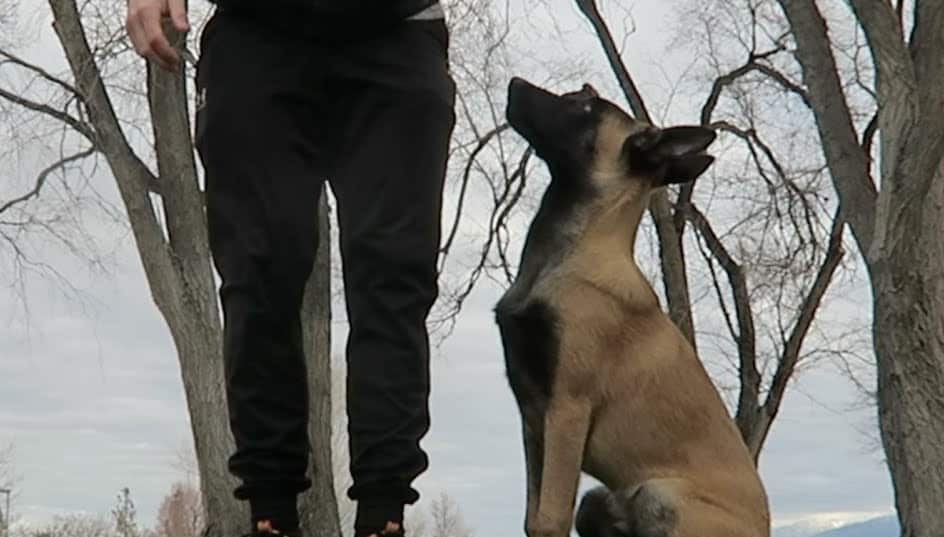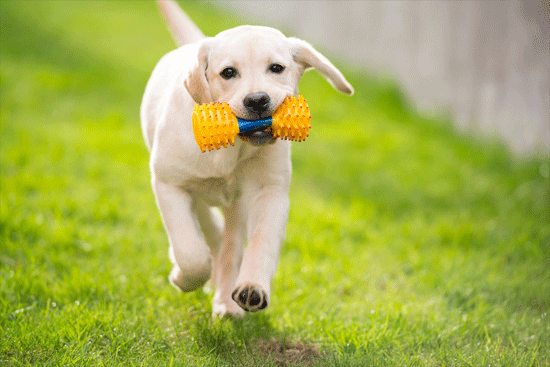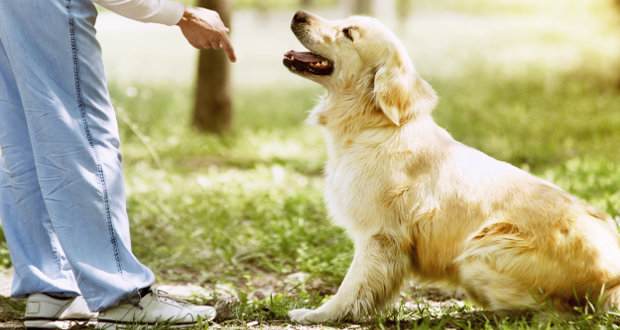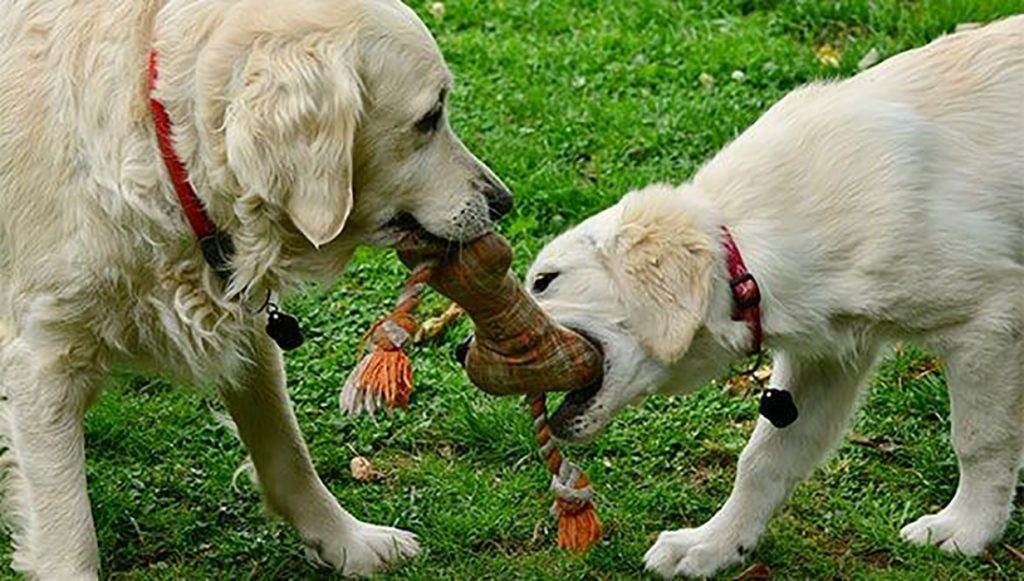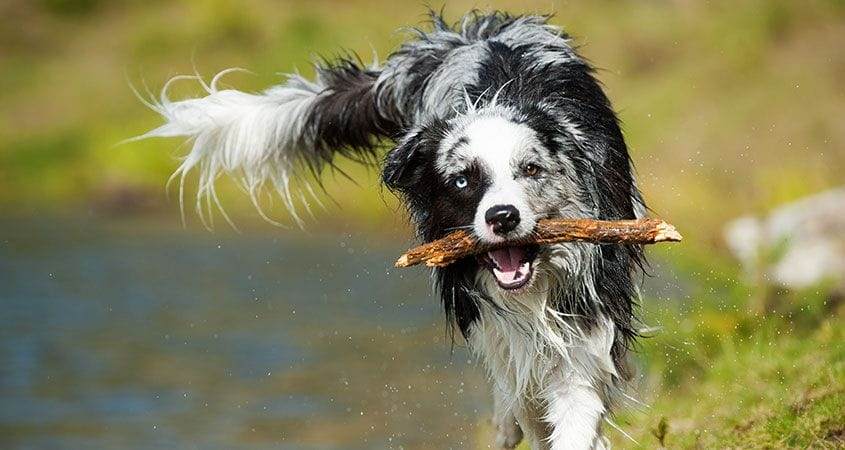In order to get your dog’s attention, you can employ techniques like the use of treats, clicker and staring at each other. The staring exercises should first start with you sitting on a chair and then you can move to stare at the dog while standing.
With time and little patience, the dog will start to give you the attention and will focus on what you want to convey to him.
Having your dog’s attention is a crucial aspect of effective dog training. If your dog doesn’t focus on you, how then can she learn anything from you? A dog’s attention may not come naturally, but it can be improved through some exercises that we will discuss here.
You’re always trying to get your dog to check in with you for information more often, or you’re just trying to teach your dog to pay a little bit more attention to you.
When I was a student at Dogs Training Classes, I was always so impressed that the instructor’s dogs would look to them for information. They even do so in a really busy environment.
Today I’ll teach you how to train your dog to look at you on command. I’m going to show you a couple of ways to reinforce those random times when your dog checks in with you for information so that they start to do it more often.
Are You Currently Able to Get Your Dog’s Attention?
This is an important question that every pet parent should consider. A dog that pays attention to you will tend to look at you regularly and follow what you do closely. Your dog’s attention is easy to notice because she will tend to follow you around while seeking your attention.
Your dog may also be the discrete kind – those that seem to show no interest in your activities, but if you disappear momentarily, they’ll be at your feet! This is your dog paying attention to you in their own discrete manner.
Your dog remains aware of your activities but prefers to let you be. She will rely on her sense of hearing and smell to track your movements.
Why is Your Dog’s Attention Necessary?
Some dog trainers believe that attention is overrated and is not a vital aspect of dog training. Such trainers believe that a dog can be forced to pay attention when demanded to do so during training.
In my experience, forcing your dog to pay attention doesn’t produce the desired results, and could, in fact, make your dog fearful or anxious.
Your dog may focus on you because she has to, or she may do it because she wants to. Dogs that pay attention voluntarily are happier and easier to train. This post seeks to help you get your dog to focus on you freely and therefore make training easier.
This will be especially helpful if you take your dog to a shopping mall. These malls could be pet friendly but still, they have rules. Read my guide on going shopping mall with your dog for more.
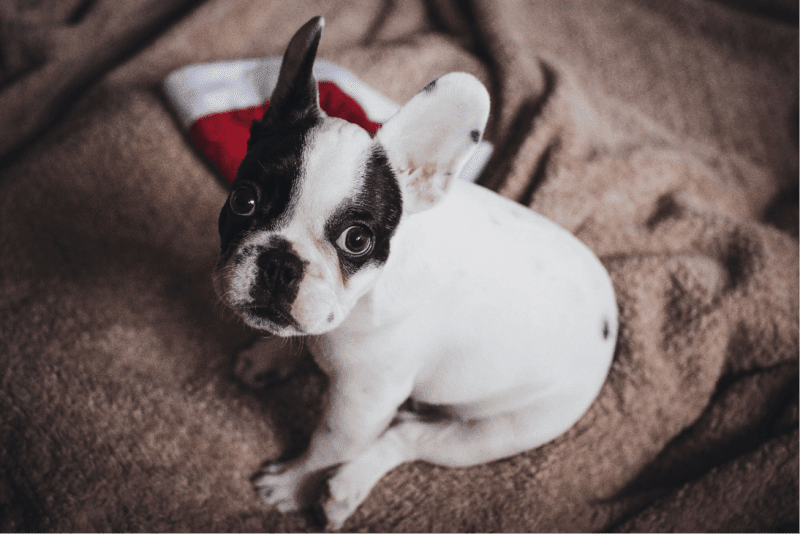
Soon Your New Dog Will be Distracted by Everything
Pet parents tend to take their dogs’ attention for granted. Well, pet parents don’t value a lot of precious things about their pets, unfortunately. When your dog first arrives at your home, she pays full attention to you at all times because she relies on you completely.
This undivided attention will however not last long. She will get familiar with the new environment, become comfortable and distracted.
Your dog will form new hobbies, and you will now have to compete for attention with her newly found exciting experiences. This is a challenge for training and your relationship with your dog.
Remaining an essential factor in your dog’s life not only sustains a great relationship with her but also makes dog training much easier. How can this be accomplished? The solution is effective and consistent training.
Dogs are Smart Enough to Know It All
Your dog can sense when you’re not paying attention to him – both physically and mentally. You have to pay undivided attention to your dog if you want the same to be reciprocated.
Your dog knows when you are distracted, and training becomes ineffective when you are distracted. Being attentive, coupled with rewards and praise, will lead to highly effective training.
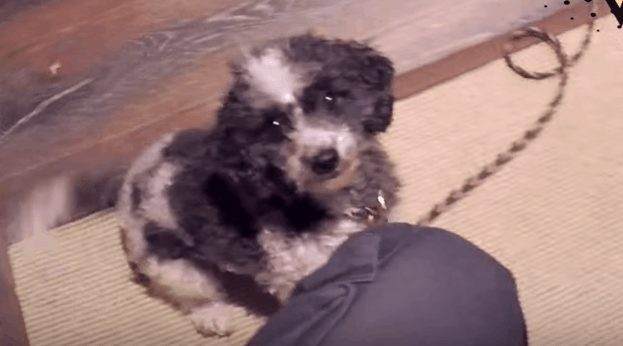
Dog Training Focus Exercises
1. Look At Me: Sitting Down in a Chair
Let’s begin this skill by making it easy for even the most easily distracted dogs to be successful. Begin this by sitting down in a chair. Get one of your dog’s favorite treats, and then put it on your dog’s nose. Say look at me, and then draw the food up towards your face.
At the moment that their eyes meet yours, I want you to yes and reward them. But something that’s really important about this exercise is that you want to reward them in a direct line between your face and theirs.
Mistakes That People Make
Often I see people trying to get this right, and they’re rewarding their dog with their head pointed away. It’s really important and keeps this in mind. Throughout every step along the way that we’re rewarding, our dogs should be looking at us. Make no mistake about it.
I understand that when I say looking at us, we already know what they’re actually looking at (the treat actually). But when I show you how to fade the food out of this skill, you’re going to start to see your dog doing an interesting thing. And remember, keep this short and sweet.
You’re going to yes the moment that their eyes meet yours and then you’re going to reward them in a direct path between your face and theirs.
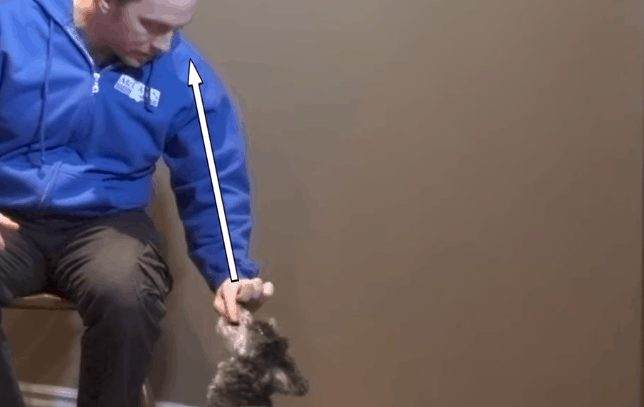
2. Look At Me: Standing Up
And at this point, we’re ready to move on to standing up. Your dog has more opportunities to make a mistake here, so make sure you keep this exercise short and sweet.
I can’t reinforce this point enough. During this exercise, make sure you’ve drawn an imaginary line between your eyes and your dog’s eyes. Anytime you’re rewarding him, reward on that line. During this step of the “look at me” skill, you’re going to reward several times, and maybe over the next day, or the next couple of days. You’re going to reward your dog multiple times just for looking at your face.
And once you feel your dog understands what you want from them (when you would say look at me), you could start to draw this process out a little bit. You can hold the food at your face for a little bit longer maybe two or three seconds, then yes, and reward them.
Mistakes That People Make
Don’t challenge your dog too much at this point. Remember, this is still a brand new skill to them. So if they’re looking away then you’re probably holding the food at your face too long. Just take a step back and shorten the period of time between the look at me and the reward.
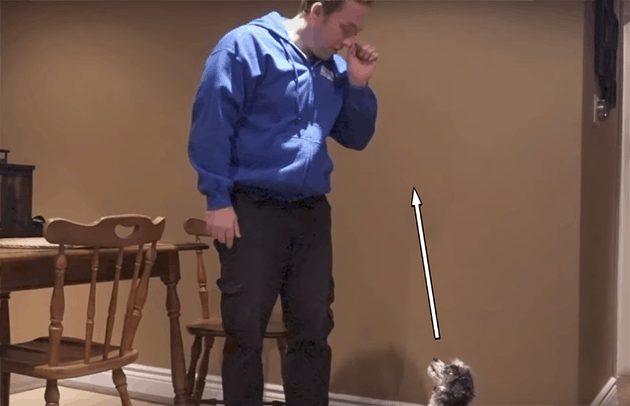
3. Step Up the Game: Remove Food from Lure
Once you’re getting your dog’s attention for several seconds at a time it’s time to make this a little bit more challenging. We’re going to remove the food from the lure during this exercise.
With no food in your hand, you’re going to put your hand on your dog’s nose. You’re going to say, look at me, draw your hand up toward your face, and then the moment their eyes meet yours you’re going to say yes.
But here’s where things get a bit more challenging. You still need to reward your dog at this point. So reach into your pocket or your bait pouch, or wherever you’ve got your treats, and then grab a piece of food. Bring that food up to your face, and then reward them in that straight line.
It’s really important that we’re yessing the moment that they’re looking at our face. That buys us the time to get that treat out to bring it up to our face, and we’re still rewarding in that direct line. But be really sure that you’re not rewarding from your bait pouch.
Mistakes That People Make
There’s a part where people often sort of go astray, and their dog finds it really confusing because now where are they being rewarded for looking? When you get that food out of your pocket or your bait pouch, bring it up to your face, and reward on that imaginary line.
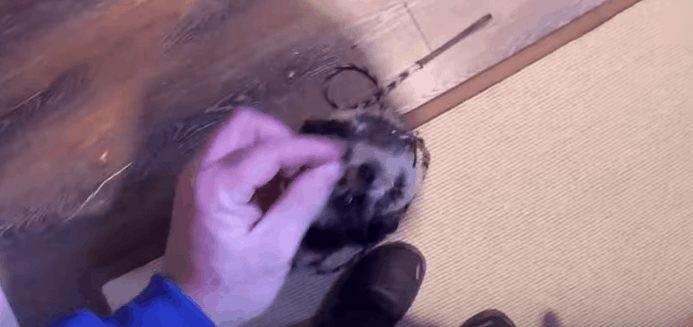
4. Repeating the Exercise is Important
Like all dog training exercises, this is all about repetition. So do this part of the exercise multiple times. With an empty hand, you’re going to say look at me, draw the hand up towards your face, yes, and reward your dog.
And you can also start to build some longevity into it. Give them a little bit more time just like we did with the food.
We really want to rehearse that great behavior of them looking at your face, and then being rewarded from your face, to build value.
5. Making it Real-Time
When you’re getting a great “look at me” for several seconds in a row with no food in your luring hand, then you’re ready to try a test. Allow your dog to get a little bit distracted, still in the sitting position, but let them look away and then say, look at me, and see what happens.
If your dog looks up at your face, immediately yes, bring that food up and reward them. If they don’t look at you, and they’re still a little distracted, it’s not a big deal.
You’re just going to repeat look at me, and then guide from their nose up to their face with no food in your hand. You’re going to have to put in a little bit more work on the “look at me” skill at that point.
6. Make It a Routine
Now that you’ve trained your dog to have a reliable skill of responding to the “look at me” command, I want you to start to build it into their everyday life.
When we have puppies in the house, we always have treats all over the place and often on us in our pockets. When our dog checks in with us, when that puppy looks up at our face, I’ll always yes, and reward them in that straight line.
It’s a really great way to reinforce checking in for information, or just the act of looking at you, and it’s a surefire way to get them to do it more often.
7. You Need to Also Allow Distractions
There is a time when I don’t want you to use your “look at me” skill. Sometimes, people feel like if they have their dog looking at their face as another person approaches, or another dog approaches that their dog’s more likely to be successful.
You know, not jumping up or remaining in that sit, but it’s actually quite the opposite. Your dog needs to know that there’s someone approaching.
Imagine if I were to say to you whatever you do, don’t look behind you. There’s somebody coming, but I don’t want you to look at them. It just creates this uneasiness.
Learn More With the Help of Video
You can always reward your dog for that beautiful sit in at your side. But it’s really important that you don’t insist that they look at you. Your dog should be allowed to check out what’s going by, and who’s coming toward them. You should be able to reinforce them for making a great choice by not going to visit those people or not going to jump up.
8. Impulse Control
Impulse control is a concept from which multiple training exercises can be developed.
- Drop a treat at your feet from your hands.
- Wait until your dog attempts to grab it, and then cover it with your foot.
- Wait for your dog to sit and look at you.
- If he does so, allow him to eat the treat as you praise her verbally.
This way, your dog learns to associate focusing on you with praises and rewards. This association grows stronger with time. His attention towards you becomes the source of good things.
Using a Clicker to Get Your Dog to Look at You?
Over the years, I have found clicker training to be very productive. A clicker keeps things consistent during training – clicker training involves a similar cue every time and enables the trainer to mark the exact moment for praise. While treats and praise are also effective, timing may be imprecise, and different rewards can yield different results.
Not every dog trainer is a fan of clicker training, though, which is Okay. Any form of well-structured positive reinforcement training will make your dog respond positively.
Conclusion on How to Get a Dog to Listen When Distracted
Attention is a crucial and fundamental aspect of dog training. Teaching your dog to focus on you is of tremendous benefit to yourself and your dog. Attention is an underutilized element of training. When your dog learns to associate paying attention to rewards, training becomes easier and more effective.
I’m excited for you to have this skill in your dog training tool belt. I’m really excited for your friends to see how often your dog’s checking in with you for information rather than being distracted by all of the other things going by.
References
- https://books.google.com/books?hl=en&lr=&id=2AO4CgAAQBAJ&oi=fnd&pg=PT13&dq=Get+Your+Dog+to+Focus+on+You+Outside&ots=FLYMo_8feB&sig=AXgLiEzmlSTru8Oy5u7tmLSa_ow
- https://www.andrealeighptak.com/s/TwYTDTXT-Sample.pdf
Table of Contents

